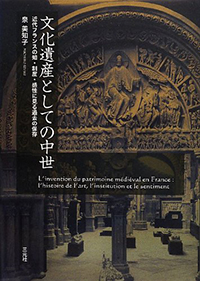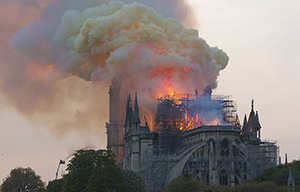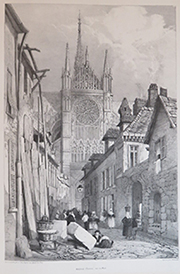What is a Cultural Heritage?
Michiko Izumi
Associate Professor, Faculty of Letters, Chuo University
Areas of Specialization: Aesthetics and Art
What is a cultural heritage?
According to a Japanese dictionary Kōjien (the seventh edition), bunka-isan (cultural heritage) means a past culture that should be inherited for future cultural development. Today, a cultural property and a cultural heritage are used for referring to almost the same thing, but a cultural heritage connotes inheritance. In French, a cultural heritage is "patrimoine", which originally meant a hereditary property that is passed down through generations within a family. The units of families expanded to regions, countries, and the world, and that word started meaning a shared property passed down in a certain group. It was the late 18th century when there emerged a mindset of preserving valuable relics that convey the course of history, and it was the end of the 19th century when a willingness to pass down them as shared properties to the next generation was set forth in law in France.
Furthermore, a cultural heritage implies not only the inheritance of goods as assets, but also the inheritance of collective memories linked to them. A monument currently refers to a large building with historic value, but the word monument is derived from a Latin verb meaning "remind someone of something." Namely, monument is a word meaning a statue or tombstone for reminding us of a certain figure or event, whose purpose is to pass down the remembrance to future generations.
In France, a system called "monument historique" (historical monuments in English) was established in 1830, designating things that are historically or artistically valuable to nations or people in the modern age as heritages. However, this did not include the respect for people's recognition of things. In parallel with the enhancement of nationalism at the end of the 19th century, people began to trace back the remembrance of their homeland and ancestors.
The study of the remembrance and spirits conveyed by cultural heritages, how to grasp them, and how to describe them would deepen our understanding of the meanings of existence of cultural heritages in the present age. Cultures cannot be inherited with artifacts only, but the above-mentioned effort is required.
Research into cultural heritages
It was only 200 years ago when a system for museums of art and protection of cultural properties was established in the long history of Europe. In France, the absolute monarchy collapsed due to the French Revolution, and the above system was established through the development of modern society. I have discussed what kinds of historical backgrounds led to the emergence and development of our common ideology for cultural heritages, that is, the mindset of protecting or preserving works of previous generations and passing down them to future generations, from the standpoint as a researcher in the history of art.
When it is assumed that an artwork has two facets, it can be said that the first facet is the work created by an artist and the second facet is the value defined by society. What I have engaged in is the research into the second facet, that is, to grasp how artworks were accepted, evaluated, preserved, and inherited in society after they left creators from a historical perspective. I study narrators rather than creators, and critics rather than artists.

1: Publication of the doctoral thesis
When discussing the formation of the ideology for cultural heritages in my doctoral thesis (Fig. 1), I focused on the re-evaluation of medieval art in the history of art. In the 19th century, forgotten works were rediscovered and reevaluated actively. The reevaluation of medieval (Gothic) art, which had been labeled as barbaric since the 16th century, was a cultural phenomenon in modern European countries. For France, which had disregarded the medieval era for a long period of time, the rediscovery of medieval art meant the review of especially antiquities in France. It provided an opportunity to ponder over the meanings of national art. The process of reevaluating medieval architecture and art and incorporating them into systems for art means the process of establishing a system for protecting cultural properties.
The stance of evaluating medieval art emerged in the intricate context of France in the 19th century. By unraveling the context, we can shed light on a variety of issues regarding politics, religion, ideology, etc. I think that research into cultural heritages progresses through the interdisciplinary study of general history, architectural history, and literature in addition to history of art.
Fire at Notre Dame Cathedral in Paris

2: Fire at Notre Dame Cathedral in Paris on April 15, 2019 (source: fr. wikipédia)

3: Notre Dame Cathedral in Paris viewed from the Seine (source: fr. wikipédia)

4: Reims Cathedral on fire (source: en. wikipedia)
In April 2019, a shocking video of the spire of Notre Dame Cathedral in Paris burning down (Fig. 2) was broadcasted as a tragedy in Paris. It was also reported that this cathedral represents the history of Paris and the destruction by fire means the loss of the identity of citizens. The president of France launched a restoration project immediately, and raised a lot of donations.
For me, who research the French cultural heritages in the 19th century, this fire means the loss of the spire that verifies the previous restoration project. Notre Dame Cathedral in Paris is a building that marked a turning point in the discussion on the protection of cultural properties in the 19th century, and the collapsed spire was designed by Eugène Emmanuel Viollet-le-Duc, who took charge of restoration of the cathedral (Fig. 3). Viollet-le-Duc was an architect who restored historical buildings in France, and his restoration methods have been so far discussed from various perspectives. In the restoration project, French people will discuss whether or not to restore the spire designed by Viollet-le-Duc.
As for the idea of protecting cultural properties in France, people have conducted repeated discussions while overcoming the tribulations of destruction. Cultural properties were destroyed by major revolutions, modernization, restoration, war, and deterioration. Every time people were faced with a problem, they reevaluated cultural properties and discussed how to protect and preserve them for inheriting them from previous generations. What we recall as a major fire at a cathedral since the modern age is the fire at Reims Cathedral during the First World War (Fig. 4). That fire was ignited by the bombardment by the German Army, and the image of the cathedral on fire was distributed by the media around the world. There was an opinion that citizens should keep the state as it is even if it is destroyed, rather than restoring the building.
In the current case of Notre Dame Cathedral in Paris, the possibility of such an option was not discussed, and restoration was declared on the day of the fire accident based on presidential power. I would like to see what kinds of ideas will be adopted for restoration, while comparing them with the idea of preservation in the 19th century from the historical perspective.
Cathedrals and travels in France in the 19th century
In my current research, I would like to study the issues of cultural heritages with the images of the cathedrals in the 19th century. The works familiar to us include the series of pictures of Chartres Cathedral by Corot and the series of pictures of Rouen Cathedral by Monet, but I am more interested in the block prints, photos, and sketches for illustrations in books (Fig. 5) rather than oil paintings. This is because these images could be copied so as to reach more people and I considered that the study on purposes of use of these images would contribute to the discussions on the viewpoints of people.



5: Amiens Cathedral in Volume 1 of Picardie Edition of Voyages Pittoresques et romantiques dans l'ancienne France by Taylor, Nodier, and de Cailleux (1835) (stored at the National Museum of Western Art)
For analyzing the images, I set travel as the theme. In Europe, travel was closely linked with the experience of appreciating artworks. It has been pointed out that we can see the precursor of today's descriptions from the viewpoint of history of art in Description of Greece written by Pausanias in the late 2nd century, not to mention travel accounts in Italy by Goethe and Stendhal. In the 19th century, the technologies for transportation means advanced dramatically, allowing more people to travel, as opposed to only high-class people could afford to travel in the past, and guidebooks were produced. I would like to study the various viewpoints toward cathedrals while focusing on new sensibility nurtured by the travel culture.
- Michiko Izumi
Associate Professor, Faculty of Letters, Chuo University
Areas of Specialization: Aesthetics and Art - Michiko Izumi was born in Tanabe City, Wakayama Prefecture in 1969.
In 1992, she graduated from the Faculty of Letters, Keio University.
In 2000, she completed the Master’s Program in the Graduate School of Letters, Keio University.
In 2007, she completed the required courses for the Doctoral Program in the Graduate School of Arts and Sciences, the University of Tokyo, and withdrew from the school without a doctoral degree.
In 2010, she obtained her PhD (the University of Tokyo).
She has been serving as Associate Professor in the Faculty of Letters, Chuo University since 2019.
She specializes in systems for fine arts in France in the modern era (art museums, protection of cultural properties, and history of art), criticisms of art in France in the 19th century, and how architecture is expressed in literary works.
She currently researches how cathedrals were expressed in France in the 19th century (discussing the viewpoints toward cathedrals by studying block prints, photos, and sketches for illustrations in books).
Her major written work is Medieval Era as Cultural Heritages: Preservation of the Past from the Viewpoint of Knowledge, Systems, and Sensibility in France in the Modern Era (Sangensha, 2013), and her major theses include “How to describe the History of National Art: A Study of the Retrospective Exhibition for French art at the 1900 World Fair”, Studies in Western Art Special Feature: Memory and Oblivion (Issue No. 17, 2013, pp.130-149), “The Myth of Smiling Angel at Reims Cathedral: The First World War and Heritages in Crisis”, Kokugakuin Daigaku Kiyō (Issue No. 57, 2019, pp.29-50) and more.








